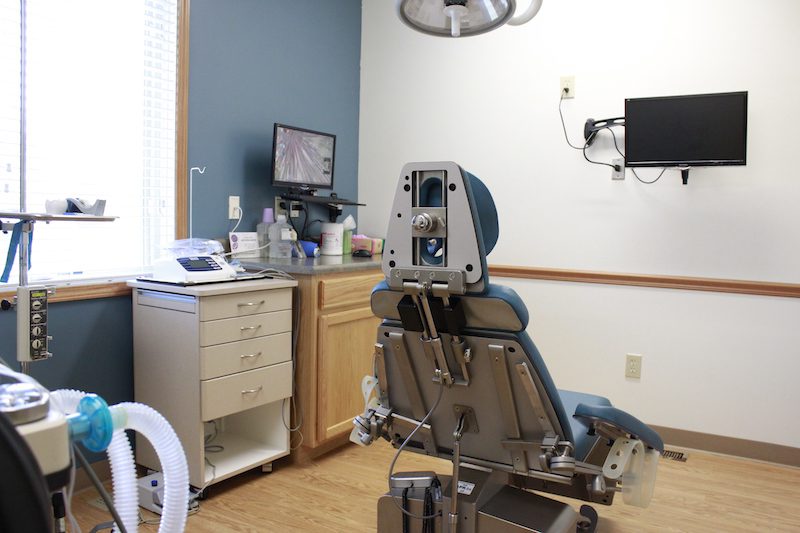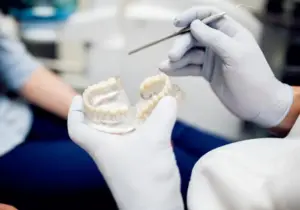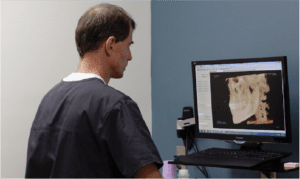
We get it — oral surgery is not on the top of anyone’s bucket list. There’s the potential dental anxiety, the pain associated with surgery, and of course the recovery time. And then there’s also the sedatives used in oral surgeries. The number one issue people have concern with is sedation: How is it administered for oral surgery? How safe is it? Especially when dealing with general anesthesia, sedation for oral surgery can be daunting; being put under causes many patients anxiety when many anesthetics for mouth surgeries are actually intended to help with it. Is the concern valid from an emotional standpoint? Of course! Lengthy oral surgeries can be downright intimidating. But there’s nothing to be worried about; sedation dentistry is one of our specialties.
As a doctor of dental and maxillofacial surgery, Dr. Puckett is licensed and certified to offer all forms of sedation available for oral surgery. Our priorities are your comfort and safety. We thoroughly review your medical history and discuss with you in detail your options for anesthesia during the consultation before your procedure. If you have any lingering questions about your surgical mouth procedure coming up or questions about the forms of anesthesia used in oral surgeries, let us know. Went want to help. We care; we’ll be gentle. Relax! You’re in good hands.
What forms are available when it comes to sedation for oral surgery? That depends on the nature of the procedure, health considerations and comfort needs. In most cases, you’ll be awake in some form — the exception, of course, is general anesthesia. When most people hear the word “sedation” or their doctor discusses using a sedative administered for oral surgeries, they tend to think of general anesthesia. While it’s a powerful and effective anesthetic for mouth operations, there are other, less invasive options that are used much more frequently.
The 4 Levels of Sedation Administration for Oral Surgery
Most applications of sedation are paired with a local anesthesia, up until general anesthesia. There are generally 4 levels of sedation available for oral surgery:
- Minimal Sedation: You are fairly awake and cognizant, but highly relaxed.
- Moderate Sedation: Also known as conscious sedation, this form leaves you relaxed and groggy. You may slur your words and may not remember much of the procedure.
- Deep Sedation: You are on the edge of consciousness but can be easily awakened. For all intents and purposes you’ll be asleep, but not deeply.
- General Anesthesia: You are completely unconscious, pretty much knocked out. We typically reserve this form for extensive oral surgery.
As you can see, there are quite a few primary types of sedation. Most surgeries like wisdom teeth removal, having artificial tooth implants installed, and others fall somewhere within the minimal to moderate section. Patients who experience high levels of dental anxiety to the point where it’s debilitating and affects their ability to sit still in a chair might receive moderate or deep sedation for when they go in for an oral operation.
Application Methods of Sedation for Oral Surgery
Different patients have different needs and safety concerns, depending on their age, health, and the surgery being performed on their face, jaw or mouth. An oral healthcare provider will discuss these factors with the patient to determine the best course of action and which kind of sedative used in oral surgeries is appropriate for them. These factors are the reason why there are several applications for anesthesia and sedation in the first place.
Inhaled Minimal Sedation for Simple Procedures
For minimal oral sedation, you can inhale nitrous oxide, otherwise known as laughing gas, which is combined with oxygen and administered through a mask placed over the nose. Nitrous oxide helps patients feel more relaxed and comfortable — it also provides significant analgesia (pain control). It can even be used for minor procedures. The idea is to just help you relax and ease your anxiety. You can readily control your gas intake by asking us to raise or lower the amount you are given. The gas is highly relaxing.
Nitrous oxide is the least invasive sedative used in mouth surgeries. You’re fully awake during the process, but you’ll be giggly and relaxed. This is sometimes used in conjunction with a localized anesthetic, which numbs the operating area. A lot of people confuse nitrous oxide and general anesthesia administered for oral operations for the same thing, but they couldn’t be more different.
However, we don’t use nitrous oxide at Wilmington Oral Surgery; it’s not a necessary method of sedation for oral surgery; there are safer and just-as-effective methods. Take a look:
Oral Sedation for Mouth Surgeries
Sedation is also available in a pill form that can range from minimal to moderate effects. The most common method of sedation dentistry is to administer Halcion, a member of the same drug family as Valium.
Typically, you take it an hour before the procedure. You’ll feel drowsy, but still awake. We can increase the number of pills taken for a more moderate approach to sedation. You may fall asleep during the procedure but can be gently awakened following completion.
Intramuscular Sedation for Children
This type of sedation works well with young children, who might be scared of inhaling something and/or unable to swallow pills yet. As the name implies, the sedative goes into the upper arm muscle, sort of like a vaccine. From there, it acts like any other mild sedative used in oral operations. It’s also true that those other forms of mild-to-moderate sedation for oral surgery may come with more risks for children than adults. We think it’s always better to err on the safe side – pediatric oral surgery can be scary for a kid; we make it as calm, safe and simple as possible. Like any of our adult patients, we welcome questions and concerns relating to oral surgery performed on children or the kind of oral surgery sedative used.
Intramuscular sedatives are administered through a small injection, usually through the shoulder. The effects take 5 minutes. In no time at all, the child will be relaxed and ready for the surgery that lies ahead. In the hours following the operation, the child patient will be back to their normal selves. We use advanced monitoring to ensure the safety of the child. Intramuscular sedation is a safe and effective form of oral surgery sedation that is highly reliable. Intramuscular sedatives for oral surgeries keep the patient awake, and does not produce the same effects as a deep sedative like general anesthesia.
IV Moderate Sedation
Another approach to moderate oral surgery sedation is through an IV, administered through a vein. This allows the effects to come on more quickly. This method of sedating you for your procedure allows us to continually adjust treatment levels throughout the procedure, closely monitoring the patient throughout the procedure. IV sedation is used in oral surgeries like getting your wisdom teeth taken out, having a titanium dental implant installed in the jawbone, and other slightly more involved procedures that still don’t warrant full-on general anesthesia. It’s also sometimes called “twilight sedation” due to the fact that your body is still fully awake, but you don’t remember much of anything—if anything at all—about the operation that was just performed.
While you may fall asleep during the procedure, you’re easily woken and responsive to the people in the room. You’ll likely feel groggy when you come out – as if you’ve had a nap. Moderate IV sedation lowers your heart rate and blood pressure during your orofacial procedure, so your body and your mind are relaxed. While it’s still considered a very safe and effective form of sedation for oral surgeries, patients who undergo IV sedation are still monitored closely. Once you come to, the effects of the sedative used dissipate from your body over the course of the next handful of hours. With IV sedation, you’ll still want a friend or family member to drive you home after your procedure.
Deep Sedation & General Anesthesia for Complicated Oral Surgeries
We can give you medications that make you almost or completely unconscious. If you prefer, you can be deeply asleep with no memory of the procedure. Under general anesthesia, you cannot be easily awakened until the medication has worn off. General anesthesia is the most intense form of sedatives used by oral surgeons. This form is used for only the lengthiest kinds of procedures like impacted wisdom teeth removal, or large procedures like a full mouth reconstruction operation. Generally speaking, we don’t like to use general anesthesia unless it’s absolutely necessary.
This oral surgery medication is administered through a small IV placed into a vein. The anesthesia is fast acting and short lasting. This allows small doses to be administered that are very safe and highly effective. When the oral surgery is complete, we stop administering the medication so you wake up relatively quickly. Nausea is fairly uncommon and can be avoided in susceptible patients. Like IV sedation, you’ll also need a friend or family member to drive you home following an oral surgery that makes use of general anesthesia. Most patients who undergo general anesthesia will be groggy and slightly “out of it” for a handful of hours following the procedure and should have an eye kept on them at home.
How Safe is Sedation in Oral Surgeries?
Before we administer general anesthesia, we conduct a pre-anesthesia assessment. You complete a health history form, and we perform any needed tests and get medical clearances from other specialists. These will determine your risk for complications from general anesthesia, and help us decide what kind of sedation to use.
Oral and Maxillofacial Surgeons (OMS) are one of the few medical specialists, and the only dental specialist, that are mandatorily trained with the core knowledge and skills to administer IV sedation and general anesthesia to provide patients with the highest level of safety and comfort.
Every OMS residency includes at least four years of anesthesia training along with the other surgical training. Four to six months are spent in the Anesthesiology Department of a hospital administering general anesthesia to patients. Residents routinely manage the ventilators (machines that breathe for the patient while asleep).
OMS residents also learn to perform tracheostomies, cricothyrotomies, and proper placement of intubation tubes to maintain the airway in the event of complications. The proper use of emergency, life-saving medicines is also part of the training.
Dr. Puckett has extensive training and over 20 years of experience performing oral surgery procedures with IV sedation and general anesthesia, and he is accredited by the state of Ohio.
Why Would I Need Sedation for My Oral Surgery?
You might be wondering – if all we’re doing is a simple tooth extraction, why would we even offer sedation dentistry? If you have dental anxiety, you already know why. Reasons we might recommend sedation along with anesthesia for your procedure include:
- If you have very sensitive teeth
- If you have an active or overactive gag reflex
- If your dental anxiety prevents you from sitting still in the chair
- If you have a low threshold for pain/discomfort
- If you are more resistant to anesthesias
- If you have a movement condition, such as Parkinson’s, epilepsy or a history of seizures
- If you have heart problems
- If the patient is neurodivergent in a way that makes the oral surgery distressing to them and/or difficult for the surgeon to complete
- If the patient is a small child
- If the orofacial surgery is complicated, extensive, long, etc.
Talk to your maxillofacial surgeon about your options for sedation for oral surgery. Whether you’re having your wisdom teeth removed, getting a dental implant, full mouth reconstruction, or other oral surgery, we have a variety of sedation methods and pain remedies available. If you have any questions surrounding the sedatives used, let us know. We love talking dentistry with our patients, and we’ll do everything in our ability to make you feel relaxed and ready to take on your procedure with confidence. Your comfort is our priority!








